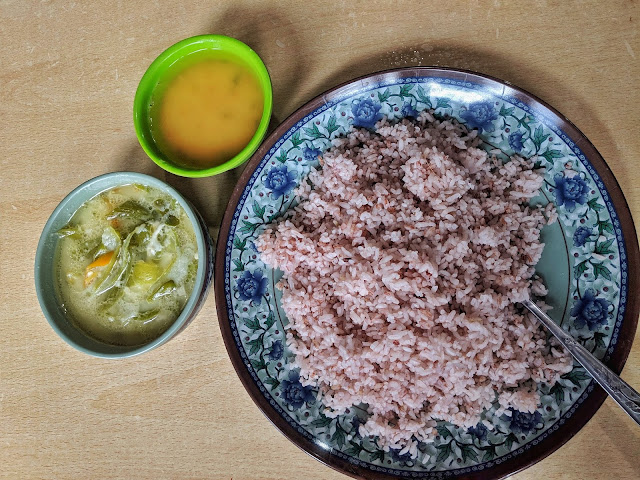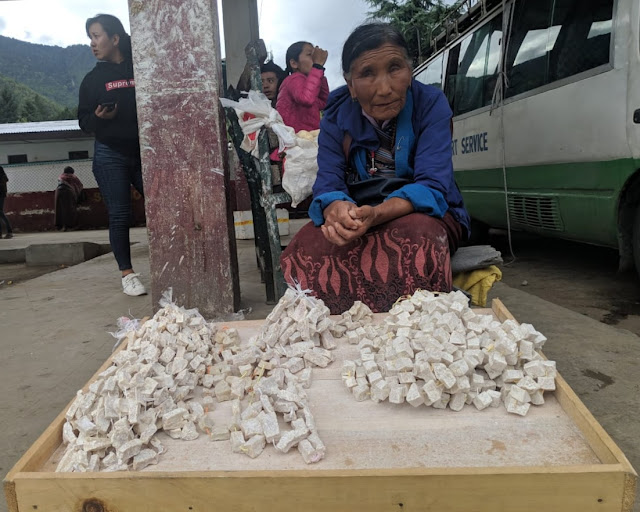After a 5-hour journey from
Thimphu, we reached Haa. This sparsely populated and traditional town is scenic
and surreal. The town is untouched by outside influence and the residents
believe in a simple, humble, traditional lifestyle. No high-end restaurants or
hotels are available here. We opted to stay at Chimmi homestay with an old
Bhutanese couple. It was almost dark when we reached so we spent our time
indoors; eating home-cooked Bhutanese meal made with freshly plucked vegetables
from the garden and listening to the couples’ stories of the town.
 |
| HAA VALLEY, BHUTAN |
DAY 3: Haa and Chele La Pass
The morning view from the stay was
stunning. After walking just a few steps from our stay, we could hear the Haa
Chhu River gushing in the distance. We saw the Indian army base at Haa, where
the soldiers were practicing for their annual horse racing festival. We headed to
Lhakhang Karpo (White Temple) with our hosts where the locals had gathered to
practice for the annual festivities of Haa Tsechu. So beautiful was our
experience at Haa that we felt like we could’ve stayed here forever.
From Haa, we drove towards
Chele-La Pass. About 4000m above sea level, this is the highest motorable pass
in Bhutan. Blanketed in fog and adorned with colorful prayer flags, the pass
was a remarkable sight. The surrounding area of Chele la offers countless
hiking trails and breathtaking views of Mount Jomolhari.
Our next stop was
Paro, which is just an hour away from Chele La.
 |
| CHELE LA PASS |
DAY 4: Paro
Paro, unlike other parts of Bhutan, felt a
little too commercialized and was flocking with tourists. After checking in to
our hotel, we headed for Rinpung Dzong.
Overlooking the
beautiful Paro valley and the Paro Chhu, the Dzong is also an administrative
headquarters. Paro is home to some of the most beautiful monasteries and Dzongs including Taktsang Monastery, Kyichu
Lhakhang Monastery, Drukgyel Dzong, Ta Dzong (which is now the National Museum).
Don’t forget to shop for Bhutanese handicrafts,
stamps, and fascinating souvenirs when in Paro.
 |
| PARO, BHUTAN |
DAY 5: Tiger's Nest Trek
The next morning
we started for our trek to Paro Taktsang, famously known as the Tiger’s nest. Legend has it that
Guru Rinpoche was carried here, from Tibet on the back of Tigress and hence the
name. Perched on the edge of a cliff, this is Bhutan’s architectural wonder.
The trek is about 6km and takes about 4-5 hrs. Start as early in the morning as
you can, to finish off before noon. The trail is rugged with steep slopes and
slippery descent and can be quite tiring, but the view from the top is to die
for.
After we finished the trek and rested for a bit, we headed for Punakha.
 |
| TIGER'S NEST, PARO |
DAY 6: Punakha
Located at the confluence of two rivers Mo Chhu and Po Chhu, surrounded by hills and full of paddy fields, Punakha is scenic.
Our first stop was Chimmi Lhakhang, a beautiful monastery built in 1499 by Ngawang Choegyel located near Lobesa. The Chimmi Lhakhang also called the ‘Temple Of Fertility’,is frequented by couples seeking blessings for their newborns. Don’t be surprised to find houses with phallic paintings and shops selling phallic-shaped keychains, sculptures, and other souvenirs.
 |
| CHIMMI LHAKANG |
We also visited the Punakha Dzong, which is the second-largest Dzong in Bhutan. Beautifully constructed between two rivers, the Dzong is the center for all religious activities in Punakha. A small hike from the Dzong leads to the suspension bridge. The 520 foot long, iron-change bridge is an important part of Bhutan’s history and offers a scenic view of the valley and rivers.
We crossed the Dochula Pass on our journey from Punakha to Thimphu.
Feel the chill in the wind and see stunning views of the Himalayas from this pass. The pass is beautifully decorated with 108 memorial chortens to commemorate the death of 108 Bhutanese soldiers who died in a military operation. The pass tells the tales of the bravery of Bhutanese soldiers. After stopping for a while at the pass, we headed back to Thimphu
 |
| PUNAKHA DZONG |
 |
| DOCHU LA PASS |
DAY 7: Thimphu
We headed to the Motithang Takin Reserve to spot
Bhutan’s national animal – Takin. We also made a stop at the post office in
Thimphu to collect personalized stamps and postcards! Next, we stopped at the Buddha point where a giant golden Buddha statue sits at
the mountain Kunzangphodrang. Inside this majestic statue are 125 small Buddha statues.
We had heard a lot
about Bhutan’s traditional hot-stone bath, so we decided to try it. The tub is
wooden and has a compartment connecting it to the main water tub. Heated hot stones
from the river go in the compartment. These stones heat the water in the tub. Medicinal
herbs and barks are boiled in water and this medicinal water is added to the
tub. The hot stone bath is the perfect way to unwind after a long, tiring
journey.
When in Bhutan, party
like the locals. Thimphu has many karaoke bars. Head to one such karaoke bar and
enjoy Bhutan’s nightlife. While you are at it, try the locally brewed craft beers
and peach wine.
 |
| BUDDHA DORDENMA |
DAY 8: Thimphu Tsechu
We had planned
our trip keeping in mind the day of the Tsechu and it surely ended up being the highlight of our trip.
The Tsechu is an annual celebration held
throughout Bhutan in various Dzongs and Monasteries. The common people and
monks, dance to the sound of cymbals, flutes, yak-horns, and drums. They wear
wooden masks to demonstrate deities, animals, and manifestations of Guru
Rinpoche. People gather in large numbers at the event to seek blessings and socialize.
 |
| TENDREL THANG, TASHICHHO DZONG, THIMPHU |
 |
| MASKED DANCE AT THIMPHU TSECHU |
We witnessed this grand celebration at the Tashichho Dzong, Thimphu, and it was an experience of a lifetime!







































